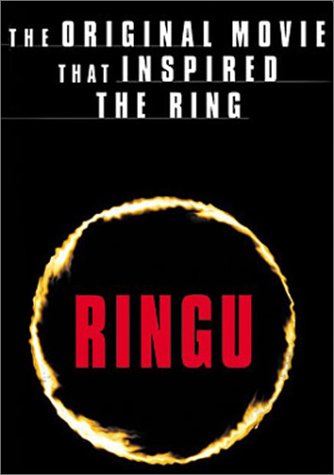Ringu review by Jackass Tom
Suprisingly Similar; not any better
In 2002, a little horror film lurked into theatres called The Ring. I saw it as did many other JackassCritics, and although not being a horror connoisseur, I was rather impressed. The camera work was done in beautiful grim blue hues, the “seven days” premise gave the movie some immediacy, and they used relatively good actors which you don’t see in your run of the mill horror film. All in all it did the trick and made sleeping a little tough the first night. Later on, I had heard The Ring was based on a Japanese horror film of the same name. This of course piqued my interest as I wanted to see how much we “Americanized” err… “bastardized” another original foreign flick. As the American version started gaining steam in theatres and later in video houses, the original foreign version became readily available to simpletons like myself… and hence, my weekend viewing of Ringu… Mwuhahhahaha….
Reiko Asakawa is a young, driven television journalist. After the eerie and sudden death of her teenage niece she begins a personal investigation. The odd, coincidental deaths of three of her niece’s close friends begin to point towards some sort of foul play. Her investigation leads a cabin where all four kids stayed a week earlier. Enter the infamous creepy video they had talked about to their friends at school; a video that was quickly becoming an urban legend. After watching it, you get a call on the telephone and in seven days you die. Asakawa watches the video, gets the phone call and starts believing the legend and fearing for her own life.
Any of that sound familiar? If you have seen The Ring this will not only sound familiar but look familiar as well. When I decided to watch Ringu I figured it could be the same premise (video, “seven days”, you are dead, scary little kids) but an entirely different movie. Usually what happens when a foreign film gets “Americanized”, not only are certain points lost in translation but often only an idea or two may remain in tact and the whole story changes. Maybe the theme changes, maybe the ending changes, or maybe even a plot twist or two are thrown in to give the audiences who have seen the original a change-up. To my surprise The Ring appears to be close to one-to-one correspondence, scene-for-scene with its Japanese original. The intro is the same: two girls sitting at home talking about the urban legend video, one has seen it and soon dies. The characters are pretty close to the same: TV journalist woman is a single mother, with one strange son, and a good, dependable male friend who we find out later is the father. Locations are similar: Cabin in an area that looks like the Northwest, spooky island on the pacific with harsh weather. Even the ending and plot twists are near exact replicas.
So obviously there are some differences. The cursed video in the American version is a little longer and has some different sequences with meanings different from the Japanese version. Likewise, there are some little parts from the Japanese video that are not in American one. All in all, I would say the one in the American version was a bit creepier. The background of the little girl is a little different, but the end result is the same. No big deal. Gore Verbinski (director of The Ring), added a few more ‘artistic touches’ in between scenes. He would start a scene by focusing on an object, like a link in a chain that resembled the mysterious “ring”. In between scenes, he often added a split second shot of a ring; just enough for audiences subliminally register. Nice touches that kept viewers aligned with the unknown obsession that the main characters had with seeing circles and drawing circles. This isn’t in the Japanese version. In the end, Ringu doesn’t do a good job explaining why the movie is called ‘the ring.’ In fact it never really makes mention of the term throughout the entire movie (which makes me wonder if it weren’t for the American version, would the title of the Japanese film in America be “Ringu”?). It’s hinted to in the end in a very indirect way but it’s not close to the explanation in the American version.
Which is better? For my money, Verbinski’s version was far better then the original. I often subscribe to the theory that copies are never as good as the real deal but I really didn’t see much in the original Ringu that stuck out as different or better. I feel I can safely recommend that if you have seen the American version, there really isn’t much of a reason to bother seeing the Ringu unless you are freakishly obsessed with the whole concept… maybe if you are getting phone calls every night counting down the days … then maybe it’s a good idea. Short of that, you are safe seeing the homogenized, pasteurized U.S. retread. For once, we ripped off a foreign movie and got it right!






6 out of 10 Jackasses blog comments powered by Disqus
Search
Ringu

IMDB Link: Ringu
DVD Relase Date: 2001-03-12
DVD Aspect Ratio: 1.85:1
DVD Extras: Reviews, Sadako's video